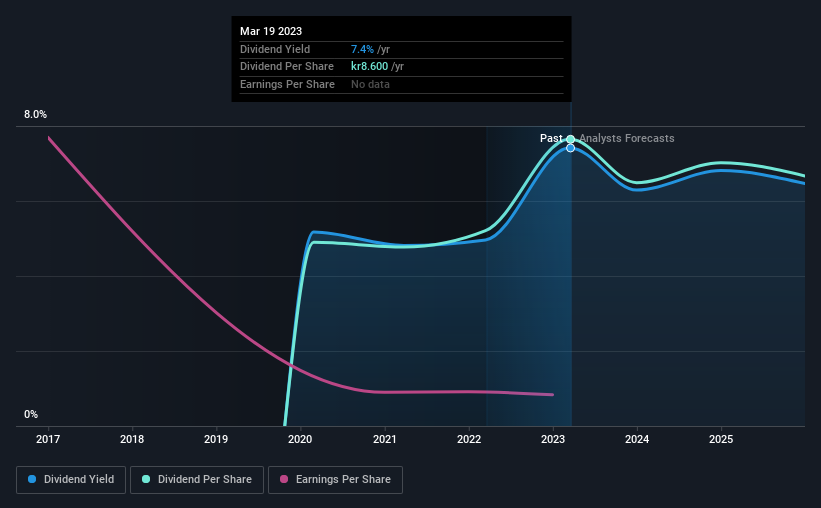Do These 3 Checks Before Buying Nidaros Sparebank (OB:NISB) For Its Upcoming Dividend

It looks like Nidaros Sparebank (OB:NISB) is about to go ex-dividend in the next four days. The ex-dividend date is usually set to be one business day before the record date which is the cut-off date on which you must be present on the company's books as a shareholder in order to receive the dividend. The ex-dividend date is important as the process of settlement involves two full business days. So if you miss that date, you would not show up on the company's books on the record date. Meaning, you will need to purchase Nidaros Sparebank's shares before the 24th of March to receive the dividend, which will be paid on the 3rd of April.
The company's next dividend payment will be kr8.60 per share, on the back of last year when the company paid a total of kr8.60 to shareholders. Looking at the last 12 months of distributions, Nidaros Sparebank has a trailing yield of approximately 7.4% on its current stock price of NOK116. Dividends are a major contributor to investment returns for long term holders, but only if the dividend continues to be paid. That's why we should always check whether the dividend payments appear sustainable, and if the company is growing.
View our latest analysis for Nidaros Sparebank
Dividends are typically paid from company earnings. If a company pays more in dividends than it earned in profit, then the dividend could be unsustainable. Nidaros Sparebank distributed an unsustainably high 150% of its profit as dividends to shareholders last year. Without extenuating circumstances, we'd consider the dividend at risk of a cut.
When a company pays out a dividend that is not well covered by profits, the dividend is generally seen as more vulnerable to being cut.
Click here to see how much of its profit Nidaros Sparebank paid out over the last 12 months.

Have Earnings And Dividends Been Growing?
Companies with falling earnings are riskier for dividend shareholders. If business enters a downturn and the dividend is cut, the company could see its value fall precipitously. As a result, it's definitely disappointing to see that earnings per share have declined 8.8% over the past year.
The main way most investors will assess a company's dividend prospects is by checking the historical rate of dividend growth. In the last three years, Nidaros Sparebank has lifted its dividend by approximately 16% a year on average. The only way to pay higher dividends when earnings are shrinking is either to pay out a larger percentage of profits, spend cash from the balance sheet, or borrow the money. Nidaros Sparebank is already paying out a high percentage of its income, so without earnings growth, we're doubtful of whether this dividend will grow much in the future.
The Bottom Line
Should investors buy Nidaros Sparebank for the upcoming dividend? Earnings per share are in decline and Nidaros Sparebank is paying out what we feel is an uncomfortably high percentage of its profit as dividends. It's not that we hate the business, but we feel that these characeristics are not desirable for investors seeking a reliable dividend stock to own for the long term. These characteristics don't generally lead to outstanding dividend performance, and investors may not be happy with the results of owning this stock for its dividend.
So if you're still interested in Nidaros Sparebank despite it's poor dividend qualities, you should be well informed on some of the risks facing this stock. For instance, we've identified 3 warning signs for Nidaros Sparebank (1 is significant) you should be aware of.
If you're in the market for strong dividend payers, we recommend checking our selection of top dividend stocks.
Valuation is complex, but we're here to simplify it.
Discover if Nidaros Sparebank might be undervalued or overvalued with our detailed analysis, featuring fair value estimates, potential risks, dividends, insider trades, and its financial condition.
Access Free AnalysisHave feedback on this article? Concerned about the content? Get in touch with us directly. Alternatively, email editorial-team (at) simplywallst.com.
This article by Simply Wall St is general in nature. We provide commentary based on historical data and analyst forecasts only using an unbiased methodology and our articles are not intended to be financial advice. It does not constitute a recommendation to buy or sell any stock, and does not take account of your objectives, or your financial situation. We aim to bring you long-term focused analysis driven by fundamental data. Note that our analysis may not factor in the latest price-sensitive company announcements or qualitative material. Simply Wall St has no position in any stocks mentioned.
About OB:NISB
Nidaros Sparebank
A savings bank, provides loans, savings, insurance, pension products, and payment services for private and corporate customers in Norway.
Reasonable growth potential with mediocre balance sheet.
Market Insights
Community Narratives




